COLUMNS
360º Architecture
28 February, 2011
From Juan O’Gorman for Diego Rivera and Frida Kahlo
The Mexican Revolution (1910-20) was followed by two decades of intense experimentation in the political, social and cultural spheres. Juan O'Gorman's radical functionalism was conceived as an agent of social and political reform.
Addressing the Society of Mexican Architects, in 1933, Juan O'Gorman, one of the pioneers and most complex figures of Mexican Modernism, stated:
the essential needs for all men are known values, exact and precise. The size of the door to a laborer's house will be the same as the door to the philosopher's house...Life imposes its economical, social, and material conditions. Technique is the means to resolve this in a better way. (By means of the better path, the maximum efficiency for the minimum effort.) This is to proceed rationally. Fellow architects: I believe that the architecture that solves the material, palpable needs that are not mistaken, that truly exist and at the same time that are fundamental and general to humans, is the real and unique architecture of our epoch.(1)
The young O'Gorman of the late 1920s and early 1930s understood functionalism and rationalism as the 'technical' resolution of programmatic requirements at a minimum of economic expenditure and waste. He defined programmatic requirements as the 'essential' material needs of 'all men...exact and precise', and viewed the architecture of uncompromising functionalism as independent of social class or wealth, and even capable of eliminating such divisions and fostering social equality in post-Revolutionary Mexico, the exact antithesis of the architecture produced for and helping to maintain the pre-Revolutionary ruling bourgeois order. O'Gorman's pursuit of a 'technical...architecture that serves mankind [as opposed to an] academic...architecture that serves money',(2) required the rigorous application of strictly rational procedures and precise calculation. 'How much air does one need in a room to sleep,' his brother Edmundo remembers him asking and proceeding to calculate the precise dimensions of the bedroom in the house Juan was designing for him in 1931. 'Juan's functionalism was extreme,' he adds.(3) Coinciding with the two decades following the Mexican Revolution (1910-20), a period of intense experimentation in the political, social and cultural spheres, O'Gorman's architecture of radical functionalism was conceived as an agent of social and political reform.
Having originally opted for medicine, O'Gorman went on to study architecture at the National University of Mexico, from 1923 to 1927. As a first-year student he worked for a manufacturer of industrial products in fiberglass-reinforced concrete, such as water tanks, and later at the practices of two of his tutors at the School of Architecture, José Villagrán García and Carlos Obregón Santacilia. Sometime between 1924 and 1926, O'Gorman bought and read four times Le Corbusier's Vers une architecture (1923). Although he later became disillusioned with the repetitive aesthetic formulas and 'Swiss Puritanism' of 'the so-called international style', and criticized severely what he had come to view as elitist and inhuman in Le Corbusier's theory - 'because man is not a machine'(4) - as a twenty-year old he found the European master's manifesto perfectly attuned with the pressing housing needs of post-Revolutionary Mexico's urban working class and impoverished rural population. In the 1920s the Mexican cement industry was also at the forefront of an effort to promote and popularize the forms, materials and techniques of modern European architecture through its official publications, which it sent free-of-charge 'to even the clergyman of every town' in Mexico. In an article of 1926, in Cemento, Obregón Santacilia praised Villagrán García's Instituto de Higiene (Popotla, Mexico City, 1925-26) for having 'the simplicity and the perfection of a machine'.(5)
While working for Obregón Santacilia, O'Gorman designed a house for the engineer Ernesto Martínez de Alba (1927-28), an exact contemporary of Gregori Ilitch Warchavchik's first house, built for himself and his wife on Rua Santa Cruz in the Vila Mariana suburb of São Paulo, Brazil. The Warchavchik house is recognized as the first Modernist house in Latin America, and shares some characteristics with the Martínez de Alba house, like the symmetrical composition of the principal façade. But O'Gorman's first house, with its reinforced-concrete structure, external staircase and roof terrace, is considerably more modern than the Brazilian one, where Warchavchik resorted to disguising the load-bearing brick walls and hiding the pitched and tiled roof in order to promote the image of the new architecture, rather than its materials and construction methods, which, to his regret, had not yet become available in Brazil.
That the house for Martínez de Alba precedes O'Gorman's conception of the role of the architect as an 'engineer' or a 'technician', may be the reason he included no reference to it in his writings. Instead, he proclaimed the house he designed for his family in 1929 on calle de Las Palmas (today calle Diego Rivera) in San Ángel, a tranquil suburb of Mexico City, the first functionalist house in Mexico. Although his parents never moved into the house, its 'strange' appearance - large, steel-framed, folding glazing panels, parapet-free flat roof, free-standing concrete elements, exposed electrical and plumbing services, proudly displayed water tank on the roof, external spiral stair without balustrade, vivid colours and a cactus fence - successfully fulfilled O'Gorman's intention to épater la bourgeoisie.(6) Like the murals in the public buildings of post-revolutionary Mexico (including O'Gorman's after he withdrew from architecture and turned to painting), the colours and cactus fences of his early Modernist houses intended to encourage people to identify with them, perhaps consciously addressing the peasants who flooded into the capital after the Revolution. Facing the colonial hacienda de Goicochea (later the San Ángel Inn restaurant), the house caused many a passerby to turn their heads away in 'horror', attests O'Gorman with obvious satisfaction.(7)
The twenty-six-year-old architect achieved an even greater succès de scandale with his house-studios for the muralist and painter Diego Rivera and his wife, the painter Frida Kahlo (1931-32). O'Gorman recounts that he found the courage to invite the 'gran maestro', twenty years his senior but already a friend and mentor in matters of art and in politics, to visit his newly constructed house on calle de Las Palmas. According to the architect, Rivera's reaction to his strictly utilitarian design, and his reference to 'beauty' were a great surprise: 'he liked the house a lot from an aesthetic point of view...At this point, Diego Rivera invented the theory that the architecture which results from the application of the most scientific functionalism is also a work of art'. To O'Gorman's delight, Rivera also pointed out that this architecture of 'maximum efficiency and minimum cost...was of enormous importance for the rapid reconstruction of our country'. The young architect put the theory into practice in 1932 when, upon Rivera's recommendation, the Marxist Secretary of Pubic Education Narciso Bassols appointed him head of the architectural department of the Ministry of Education. In that position O'Gorman built or remodeled more than fifty public schools on an extremely tight budget.(8)
During their meeting at the house of calle de las Palmas, Rivera readily agreed to buy at cost from O'Gorman the adjacent plot at the corner of calle de las Palmas and calle Altavista, and commissioned the architect to design him a house and studio. The financial arrangement suited Rivera, who had recently (on 21 August 1929) married the twenty-two-year old, fellow Communist-Party-member Frida Kahlo, and had paid off the mortgage on her parents' house. At their following meeting, Rivera instructed O'Gorman to include in his design, 'on the same piece of land, on calle Altavista, a small house of two or three storeys for his wife'.(9)
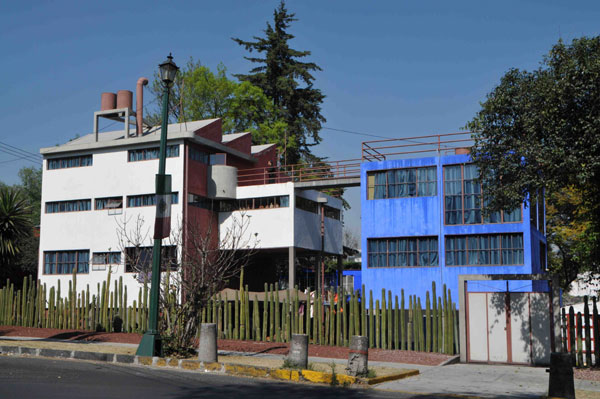
Juan O'Gorman, Double House-and-Studio for Diego Rivera and Frida Kahlo, San Ángel, Mexico City (1931-32). From 1995 to 1997, the complex was restored by its current owner, the Instituto Nacional de Bellas Artes (INBA), under the supervision of the architect Víctor Jiménez. Photograph by Styliane Philippou
O'Gorman did not simply set out to satisfy his client's needs and wishes. Like his own house and in agreement with his client, he conceived the new residence for Rivera and Kahlo as a socio-political proposal for a new way of life in post-Revolutionary Mexico. He identified with the socialist ideology of European functionalism, borrowed selectively from Le Corbusier and the Bauhaus, and mixed international sources with Mexican vernacular motifs such as bright colours and cactus fences, which he recognized as belonging to the vocabulary of rural Mexican architecture, itself supremely functional. In the 1950s, he would rail against 'imposition of foreign taste and power'.(10) But at the time he saw no contradiction between the foreign and the native, modernity and tradition, and expressed confidence in the Mexican architects' ability to mix the two and contribute to the emerging universal culture of 'contemporary man'. In 1936, O'Gorman argued that 'Architecture will have to become international for the simple reason that every day man becomes more universal, collective, and educated for the world.'(11)
He shared a birthday with Frida Kahlo (6 July), they were both natives of Coyoacán - a charming suburb of Mexico City, not far from San Ángel - and friends since their school days at the National Preparatory School. Following the commissioning of their house-studios, the newly weds spent three years in the United States, where Rivera worked on various murals, including the ill-fated one at Rockefeller Center, and attended his retrospective exhibition at the New York Museum of Modern Art (MoMA, November 1931). Construction began in June 1931, as soon as Rivera received payment for his murals at the Pacific Stock Exchange Luncheon Club and the California School of Fine Arts (today the San Francisco Art Institute). Indebted to Le Corbusier's house and studio for the painter Amédée Ozenfant in Paris (1923), featured in Vers une architecture, but far more radical in its exposure of construction materials such as reinforced-concrete structural elements and infill clay-brick panels in the gridded ceilings, and in its expressive display of industrial-tube balustrades, electric wiring and water pipes, rubbish ducts and bins, downpipes and emblematic water tanks, the Rivera-Kahlo residence shocked its viewers from the beginning. The white-and-red cube-on-pilotis for Rivera featured a north-facing wall of glass, a zigzag roof with brises soleil protecting the studio from incoming light from the west, and an external spiral staircase in reinforced concrete, which was considered a significant feat of engineering at its time. Edmundo O'Gorman tells of a small crowd that gathered expectantly on the day the formwork of the staircase was going to be removed.(12) Conscious of its importance, O'Gorman set this stair against the deep 'Indian' red wall, the colour of dried blood, as Octavo Paz has noted.
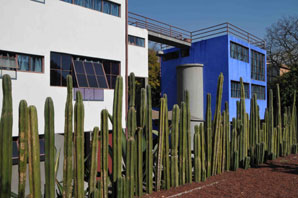
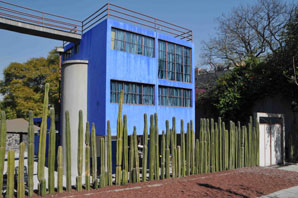
Juan O'Gorman, Double House-and-Studio for Diego Rivera and Frida Kahlo, left; Frida Kahlo's House-Studio, right. Photographs by Styliane Philippou
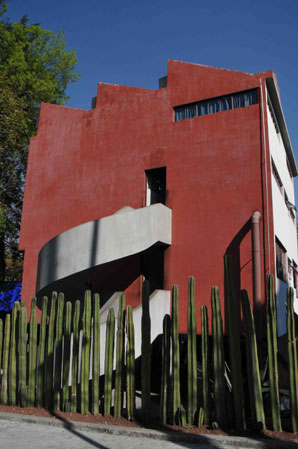
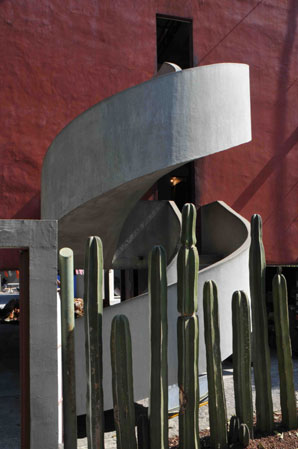
Juan O'Gorman, Diego Rivera's House-and-Studio. Photographs by Styliane Philippou
A photograph from 1929 shows Rivera and Kahlo - sporting her red Communist Party shirt - at a demonstration of the Revolutionary Union of Technical Workers, Painters, and Sculptors, of which he was a founding member. The sawtooth industrial skylights of Rivera's painting studio symbolized a rupture with the past and the forms of domesticity that the double residence rejected loud and clear, as well as Rivera's idea of the artist as a common worker among workers, the way he depicted himself in his mural of 1930 The Making of a Fresco at the California School of Fine Arts in San Francisco. The most striking feature of Kahlo's cube-on-stilts is its deep añil blue colour, similar to the one of her childhood house in Coyoacán, and traditionally used in Mexican houses to ward off evil spirits. The window steel frames of both houses were painted vermillion orange, and the riot of colour continued inside the structures: the Rivera studio had a terrazzo floor made with coloured stone chips and Kahlo's studio walls were painted parrot green. A third, much smaller blue structure, behind Kahlo's house, served as studio for the photographer Guillermo Kahlo, Frida's father.
Lola Álvarez Bravo, one of the many photographers who captured Frida's spectacular presence, remembers: 'for the layman at the time, Diego Rivera's studio was totally crazy. Everyone was saying: what could this ugly thing be? A box with some doors, and when they added colour it only got worse. Horrible complaints flooded in: atrocious colours! People said it looked like straight out of a village. Diego and Frida could not be happier among these colours, this architecture, everything.'(13) One year after his Mexican sojourn of 1938, André Breton emphasized the 'transparency' of O'Gorman's houses for the two artists, the 'reckless stair' and these elements that struck him as truly Mexican: the strong colours, the garden full of idols and cacti...enclosed by a fence of green "candles", and between these the looks of the curious who arrived from dawn to dusk, from all over America, hoping to catch revolutionary thought with their cameras, like an eagle in its nest'. Breton and his wife, Jaqueline Lamba, were also amazed by the couple's pets - monkeys and a large amardillo among them - roaming in the garden.(14)
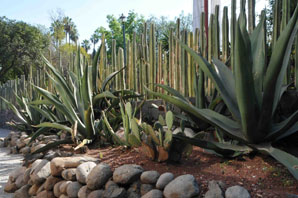
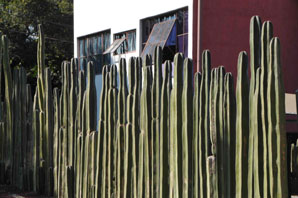
Juan O'Gorman, Double House-and-Studio for Diego Rivera and Frida Kahlo, San Ángel, Mexico City (1931-32), cactus garden, left; cactus fence, right. Photographs by Styliane Philippou
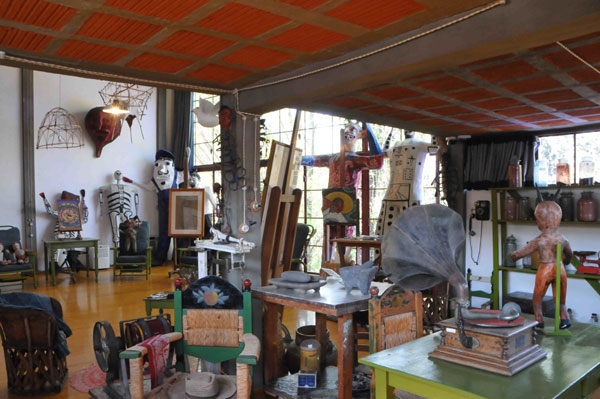
Juan O'Gorman, Diego Rivera's Studio. Photograph by Styliane Philippou
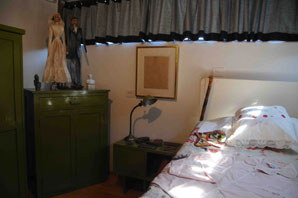
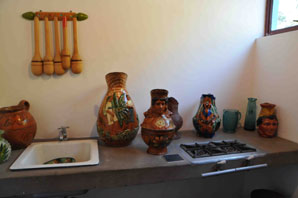
Juan O'Gorman, Double House-and-Studio for Diego Rivera and Frida Kahlo, San Ángel, Mexico City (1931-32), Rivera's Spartan bedroom, left; Kahlo's kitchen, right. Photographs by Styliane Philippou
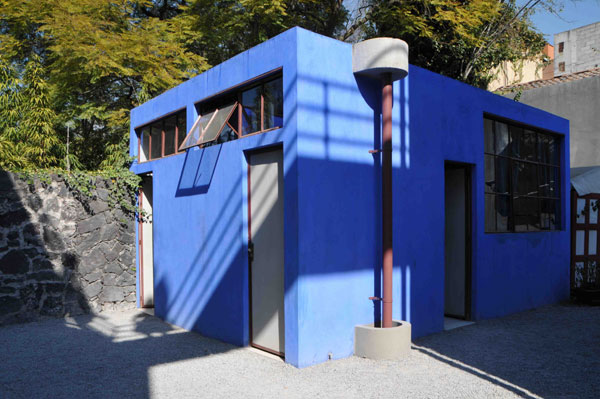
Juan O'Gorman, Studio for photographer Guillermo Kahlo. Photograph by Styliane Philippou
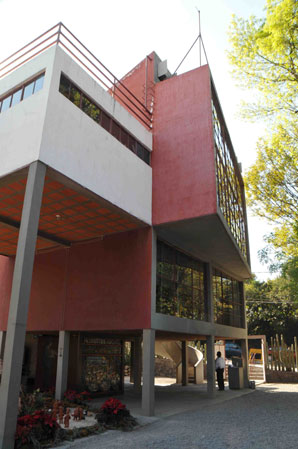
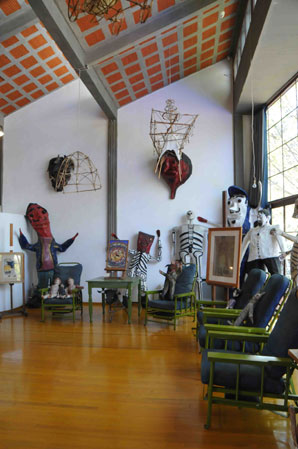
Juan O'Gorman, Diego Rivera's Studio. Photographs by Styliane Philippou
A narrow bridge at roof-terrace level connected the two structures of a programmatically detached marriage. It provided an exceptionally convoluted route out a glass door of Kahlo's studio, up a precarious, narrow and minimally protected stair along the north-facing wall of her studio to her roof terrace, across to the terrace of her husband's quarters, in to his mezzanine-level small office space and, through another couple of rooms, down to his studio space. It was certainly not a rational solution to the needs of a disabled person, let alone proof of a utilitarian approach to design. Upon their return from the United States, the couple moved into the compound in 1934. Frida Kahlo occupied her blue cube only intermittently from 1934 until the couple's divorce in 1939, being away for several months at a time. As her health deteriorated, she must have found it increasingly difficult, if not outright tortuous, to negotiate its seemingly endless, 'reckless' stairs and 'functional' roundabout routes. She nevertheless never held these issues against her architect friend. In a photograph of her last public appearance, on 2 July 1954, at a demonstration protesting CIA involvement in the overthrow of the Guatemalan government, the architect Jean O'Gorman stands on her right.
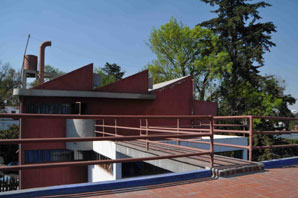
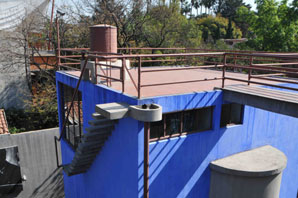
Juan O'Gorman, Double House-and-Studio for Diego Rivera and Frida Kahlo, San Ángel, Mexico City (1931-32), bridge connecting the two structures, left; detail of Kahlo's house-studio, right. Photographs by Styliane Philippou
Extract from the award-winning film Frida (2002), directed by Julie Taymor, produced by Sarah Green, Salma Hayek and Jay Polstein, and based on Hayden Herrera's book Frida: A Biography of Frida Kahlo (1983).
After their remarriage in San Francisco, on 8 December 1940, Kahlo moved back to the Casa Azul of her childhood, a squat, blue structure in colonial style, built by Guillermo Kahlo a few years before his daughter's birth in 1907. Rivera continued living and working in the house in San Ángel until his death in 1957. The house in Coyoacán was immensely more comfortable for Kahlo, with enough space for the stream of guests who visited her, for her staff and for the increasing number of carers she needed. She painted its floors bright yellow, furnished it (its original furniture had been sold) and filled it with her idiosyncratic collection of objects and pieces of pre-Columbian and folk art. In 1946, Rivera with the help of O'Gorman added a large, L-shaped, studio, clad in volcanic rock and stone mosaics, and, after Kahlo's leg was amputated, he fitted ramps for her. Now housing the Frida Kahlo Museum, the Casa Azul is forever associated with the sensational Mexican artist. Until her death in 1954, she wholeheartedly supported Rivera's last and ambitious architectural project (with O'Gorman taking over the project after Rivera's death until its completion in 1966), a monumental, neo-pre-Columbian, pyramidal structure surfaced with local lava rock, the Anahuacalli Museum, in Mexico City, conceived as a studio for Rivera and as a gift for the Mexican people, but resembling a mausoleum.
The house-studios in San Ángel had separate gate entrances: on calle de las Palmas for Rivera, and on calle Altavista for Kahlo. These underlined the idea of independence and suggested a flat hierarchy. But Kahlo's cube is significantly smaller. It also contains the only kitchen of the compound. At the time she lived there, a magazine reported that the design of the pair of 'large and small house' was dictated by Diego Rivera, and reflected his 'mormonic ideas about marriage'.(15) Kahlo liked to make fun of such reports but was probably not entirely unconcerned. A woman who changed the year of her birth (1907) to 1910 so that she could declare herself a 'daughter of the Revolution' - a 'fiction [that] exemplified her habit of calculated fabrication for dramatic effect' - Frida Kahlo was according to all evidence determined to 'invent her own biography, to plot her own myth and legend'.(16) Her marriage to the famous muralist, reported widely in the international press, thrust her into national and international artistic circles, and she relished the attention she received, even though the press was attracted to her as Rivera's eccentric and exotic wife, rather than for her own merit as an artist. Although the separate house-studios were touted as a solution to the unusual couple's needs for independent personal and professional lives, the formula did not quite work, and it is unlikely that Frida enjoyed the theatre of carrying up and down the stairs her broken body. Among other things, she may have also come to dislike the idea of a small studio for herself in the shadow of that for the great master. Her association with 'the small house' next to Rivera's 'big house' was a serious obstacle in her construction of the larger-than-life image of Frida Kahlo, and in establishing for herself a reputation as an artist of equal merit. The Casa Azul was exclusively her own domain. Rather than Frida Kahlo on an orbit around Diego Rivera, at Coyoacán Rivera was just another guest and admirer at the court of the grande dame of Mexican art. For a woman artist of her time, this was no small achievement.
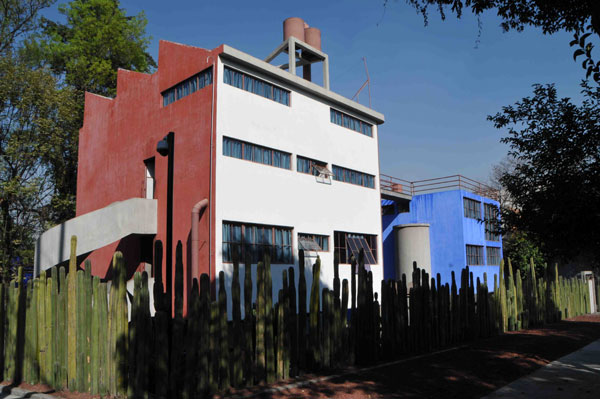
Juan O'Gorman, Double House-and-Studio for Diego Rivera and Frida Kahlo, San Ángel, Mexico City (1931-32). Photograph by Styliane Philippou
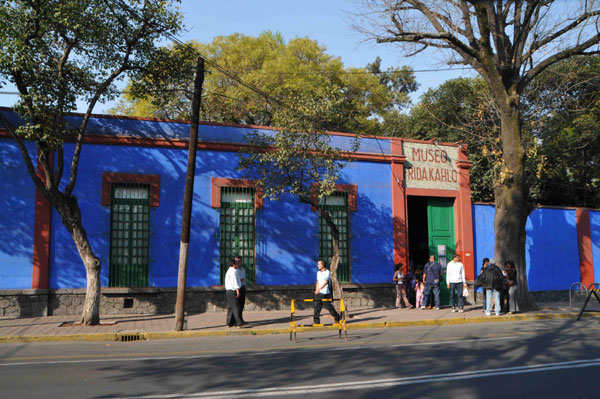
Casa Azul, Coyoacán, Mexico City (circa 1900), today the Frida Kahlo Museum. Photograph by Styliane Philippou
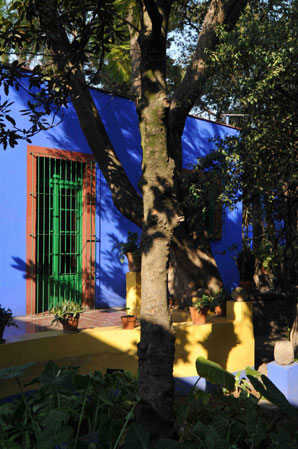
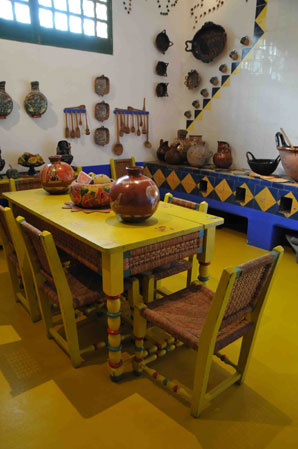
Casa Azul, Coyoacán, Mexico City (circa 1900), view from the patio garden, left; kitchen, right. Photographs by Styliane Philippou
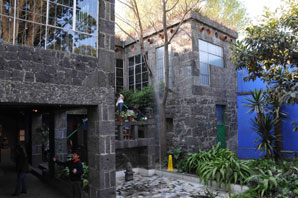
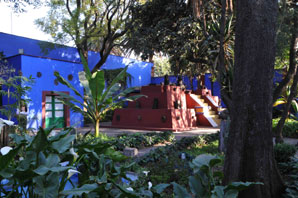
Casa Azul, Coyoacán, Mexico City, volcanic-rock-clad extension containing Frida Kahlo's studio, designed in 1946 by Diego Rivera in collaboration with Juan O'Gorman, left; patio garden with pyramid designed by Diego Rivera, right. Photographs by Styliane Philippou
Carlos Fuentes begins his essay on Frida Kahlo with a description of her head-turning entrance into her theatre box, in the Palacio de Bellas Artes in the centre of Mexico City, which left a lasting impression on him. Time and again he returns to her appearance:
Necklaces, rings, white organdy headgear, flowery peasant blouses, garnet-colored shawls, long skirts, all of it covering the broken body. Yet dress was a form of humor, too, a great disguise, a theatrical, self-fascinated form of autoeroticism, but also a call to imagine the suffering, naked body underneath and discover its secrets...The clothes of Frida Kahlo were...more than a second skin. She said it herself: They were a manner of dressing for paradise.(17)
Kahlo's costumes were a manner of dressing the icon and constructing the story. They ranged from the men's suits, boots and leather vest she wore for family pictures, to the red shirt of the Communist Party she sported in the late 1920s (a Rivera mural of 1928, Distributing Arms, at the Ministry of Public Education, in Mexico City, portrays a red-shirted, cropped-haired Frida together with her friend, the Italian photographer and at one time Rivera's lover Tina Modotti), to her favourite costume from the Isthmus of Tehuantepec (worn in Self-Portrait as a Tehuana, 1943, and in Self-Portrait, 1948), the bridal veil and crown she wore for the celebration of her tenth second-wedding anniversary in 1950, and the canopied bed she turned into a throne for her first solo exhibition in Mexico (1953), shortly before her death. She continued dressing in folk costume well after its other nationalist supporters had moved on to new fashions; her outlandish appearance gained uniqueness.
Kahlo's facial characteristics, the famous and probably exaggerated unibrow and that peach fuzz on her upper lip, the certainly exaggerated long neck and the hermetically closed mouth (concealing blackened teeth) were obsessively painted on canvas after canvas, in a ferocious effort to create an easily identifiable and unchangeable image of Frida Kahlo, like those of saints or pop stars. That there is hardly any development in her art - particularly obvious in the portraits where only the props seem to vary - or in her performances, is precisely because what Kahlo was cultivating was an icon, endlessly repeated so as to become memorable in its fixed, controlled form. In the age of mass culture her strategy works better than ever before; Frida would not disapprove of the endless reproduction of her image and legend. She used to distribute photographic portraits of herself in numbers that increased over the years. As more and more details about her life come to light, as the biographies pile up, her persona grows out of human proportions, time and distance from her world enhances the fantasy, the search for all her lost works intensifies, and the prices of her paintings rise to dizzying heights. Her family has made a brand of her name (registered trademark), and even forged personal items appear on the market.
Kahlo's insatiable attention-seeking, her narcissism and on-going complaints of loneliness - perhaps yet another deliberate ploy to underline her uniqueness and independence - her ebullient temperament, sentimental outbursts, dramatic public appearances, theatrical manners and flamboyant mannerisms - linguistic, sartorial or other - her penchant for story-telling - always with a good dose of exaggeration - her taste for vulgarity, her talent for role-playing, prop-inventing (including weird pets) and stage-setting - in life and in painting - all show that she valued artifice above art, visual décor over form, style over content. Hers was a somewhat camp sensibility, and as Susan Sontag says, 'the androgyne [an image Kahlo projected] is certainly one of the great images of Camp sensibility'.(18) Theatricality and extravagance were the means to achieve celebrity status. Frida Kahlo was perhaps the first artist whose celebrity mattered more than her art. It is not her endless ordeals that attract the attention of today's worshipers of Frida's idol, but her theatricalization of these experiences. In what is perhaps the most insightful interpretation of the artist Frida Kahlo, Germaine Greer has written:
It is no small praise to say that Kahlo was the first ever true performance artist, that the performance lasted all her life long, and that she was indefatigable in presenting it, year on year, day by day...To consider Kahlo as a painter only is to confuse one part of the performance for the whole and, moreover, to find her wanting. As a maker of two-dimensional images she is, despite the vast range of motifs she includes, deliberately unsophisticated. She does not want anyone viewing her work to be sidetracked by the paint quality or seduced by the composition. The paintings function as advertisements; they are the hoardings announcing the stages in the performance.(19)
The house O'Gorman designed for Rivera and Kahlo caused a sensation. But she could not permit the architect - or her husband - to distract the audience from her performance. The Modernist structure served the purpose of adding one more fascinating chapter to the story of Frida Kahlo. Like all her other attention-grabbing garb, it was inhabited with pride and delight, despite the inconvenience. It also granted Kahlo one more great set of roles and attributes: patron of the architectural avant garde, and sponsor of the kind of experimentation that was believed to aid the rapid reconstruction and the social and political transformation of post-Revolutionary Mexico. But she could not afford to take the risk that the stage - or her husband - might steal the performance.
Notes
1 Quoted in Burian, Edward R., 1997, 'The Architecture of Juan O'Gorman: Dichotomy and Drift'. In Burian, Edward R. (ed.), Modernity and the Architecture of Mexico (Austin: University of Texas Press), pp. 130-31.
2 Quoted in Carranza, Luis E., 2010, Architecture as Revolution: Episodes in the History of Modern Mexico (Austin : University of Texas Press), p. 156.
3 Quoted in Guzmán Urbiola, Xavier, 2007, Juan O'Gorman: Sus Primeras Casas Funcionales (Mexico City: Universidad Nacional Autónoma de México and Instituto Nacional de Bellas Artes y Literatura), pp. 46 and 28.
4 See Eggener, Keith, 2009, 'Juan O'Gorman versus the International Style: An Unpublished Submission to the JSAH', Journal of the Society of Architectural Historians, Vol. 68, No 3, September, pp. 301-307.
5 Israel Katzman and Carlos Obregón Santacilia, quoted in Carranza, pp. 125 and 126.
6 Juan O'Gorman, quoted in Guzmán Urbiola, p. 21.
7 In Guzmán Urbiola, p. 25.
8 Eggener, 2009, p. 302.
9 Quoted in Guzmán Urbiola, pp. 30-31.
10 Quoted in Eggener, 2009, p. 303.
11 Quoted in Eggener, Keith, 2001, Luis Barragán's Gardens of El Pedregal (New York: Princeton Architectural Press), p. 99. Following his rejection of functionalism, O'Gorman would later call for 'a Mexican architecture' for Mexico (1951). Eggener, Keith L., 2000, 'Contrasting Images of Identity in the Post-War Mexican Architecture of Luis Narragan and Juan O'Gorman', Journal of Latin American Cultural Studies, Vol. 9, Issue 1, March, p. 30.
12 Quoted in Guzmán Urbiola, p. 50.
13 Quoted in Guzmán Urbiola, p. 48.
14 Quoted in Guzmán Urbiola, pp. 64-65.
15 Guzmán Urbiola, p. 57.
16 Zamora, Martha, 1990, Frida Kahlo: The Brush of Anguish, translated and abridged by Marilyn Sode Smith, http://www.american-buddha.com/lit.fridabrushanguish.toc.htm
17 Fuentes, Carlos, 1995, 'Introduction'. In The Diary of Frida Kahlo: An Intimate Self-Portrait (New York: Harry N. Abrams), pp. 7-24.
18 Sontag, Susan, 2001, Against Interpretation (London: Vintage), p. 279.
19 Greer, Germaine, 2005, 'Patron Saint of Lipstick and Lavender Feminism', Tate etc., 4, Summer, http://www.tate.org.uk/tateetc/issue4/kahlo.htm
Related articles:
- 360 Degrees Architecture ( 10 October, 2009 )
- Τhe Roots of the Industry of the Image ( 27 October, 2009 )
- Anish Kapoor: Non-objective Objects ( 26 November, 2009 )
- Love Thy Planet ( 28 December, 2009 )
- Europe’s Civilization under Threat ( 28 January, 2010 )
- Made of Stone and Water, for the Human Body ( 28 February, 2010 )
- Bokja: ‘A Woman’s Affair’ ( 28 March, 2010 )
- Brasília from the Beginning, Fifty Years Ago ( 07 April, 2010 )
- Brasília, ‘capital of the highways and skyways’ ( 30 April, 2010 )
- Oscar Niemeyer’s Permanent International Fair in Tripoli ( 29 May, 2010 )
- Learning from Miami ( 10 July, 2010 )
- The Greatest Show on the Beach ( 08 August, 2010 )
- Oscar Niemeyer: Curves of Irreverence ( 28 March, 2011 )
- The Lizards of Djenné ( 26 September, 2010 )
- Transformed by Couture ( 29 October, 2010 )
- Another Athens Is Possible ( 02 December, 2010 )
- Roberto Burle Marx: The Marvellous Art of Landscape Design ( 27 May, 2011 )
- The Danger that Lurks on this Side of the Gates ( 10 September, 2011 )
- Eduardo Souto de Moura ( 21 November, 2011 )










